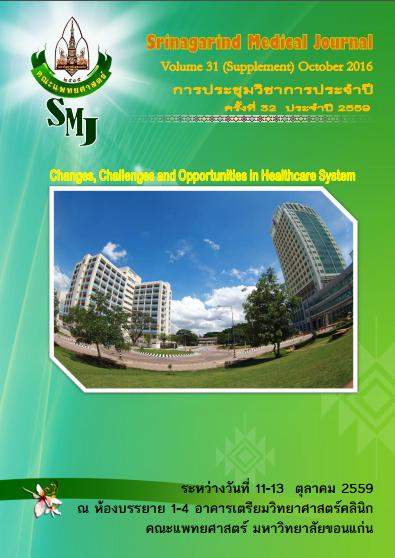Behaviors and Factors that May Associate with Online Educational Assessment Questionnaires Response of Medical Students Khon Kaen University
Keywords:
educational assessment questionnaires, medical student, Khon Kaen UniversityAbstract
Background and Objectives: Online educational assessment after completion of the program is an important factor in developing the education. Knowing behaviors and factors that may associate with providing feedback will have benefits on developing questionnaires and ultimately the education. The study aimed to examine 1) Proportion of responding questionnaires behavior 2) Associated factors to complete the questionnaires and 3) Knowledge and opinions of completing questionnaires in medical students Khon Kaen University 2015
Method: Descriptive study at Faculty of Medicine, Khon Kaen University. Target populations were all preclinical and Srinagarind clinical student who have been enrolled in the educational year of 2015 for 1,066 students. Stratified sampling was used to select 428 study populations. Selected samples were preclinical student for 334 students and Srinagarind clinical student for 94 students. Tools and measurements: Self-administered questionnaires. Statistical analysis: SPSS-PC v.19 was used to analyze descriptive statistics (proportions,percentage,frequency, Pearson Chi-square, Fisher's exact test,Odd ratio,95% confidence interval)
Results: The response rate was 96.26%, 18.5% (95% CI: 14.9, 22.7) of the respondents always completed questionnaires themselves with completely read and understood all the questions which were preclinical student 21.2% (95% CI: 16.9, 26.1) and clinical students 8.9% (95% CI: 4.2, 17.3). Too many questions and duplicated questions had relation with responding behavior in all medical students with statistical significance (OR = 0.35 (95%CI 0.18, 0.68) and OR= 0.56 (95%CI 0.32, 0.98) in order). Preclinical and clinical students had the same attitude on educational assessment that they would have benefits (86.3%). Most of preclinical and clinical students knew that the results was used to improve teaching and learning (71.7%), the results can use to assess instructor’s key performance index (73.0%) and instructors can’t identify the respondent (66.7%).
Conclusion: A very small amount of preclinical and clinical students always complete the questionnaires themselves with completely read and understood all the questions. Too many questions and duplicated questions had relation with responding behavior in all medical students with statistical significance. Most medical students had the same attitude on educational assessment that they would have benefits and knew thatthe results was used to improve teaching and learning, the results can use to assess instructor’s key performance indicator and instructors can’t identify the respondent.




